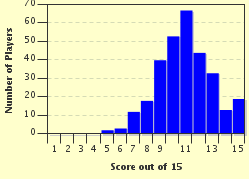Quiz Answer Key and Fun Facts
1. The sun always rises due east and sets due west.
2. There is more land in the northern hemisphere than in the southern hemisphere.
3. Humans existed at the same time as dinosaurs.
4. The atomic number of gold is 79.
5. Brown is a spectral color.
6. In the Lewis theory, if an acid reacts with a base, one result is always water.
7. Venus is a habitable world.
8. During a radioactive decay, a substance never changes.
9. Plants are green due to the presence of chlorophyll.
10. Infinity can be defined as the reciprocal of zero.
11. Clouds form mainly in the stratosphere.
12. One mile is 5000 feet.
13. The speed of light is the cosmic speed limit for particles having positive mass.
14. Uranus is the Solar System's outermost planet.
15. The star constellation Felis (the cat) currently exists.
Source: Author
Earthboy
This quiz was reviewed by FunTrivia editor
WesleyCrusher before going online.
Any errors found in FunTrivia content are routinely corrected through our feedback system.


